Growing basil in the garden is a popular activity in the spring and summer months. But, the plants are not cold hardy so quickly die off in the fall. You can get the best of both worlds by growing basil in containers outdoors, then bringing them inside during fall and winter. However, growing basil indoors is possible whether you have a garden or not.
How To Grow Basil Indoors
It’s not difficult to learn how to grow basil indoors. It can be grown on the kitchen windowsill for use in cooking, for making aromatic oils, or simply to add interest to an indoor herb garden. Our expert guide will take you through the key steps, from planting to care, and harvesting.
How To Care For Basil Indoors
Basil plant care indoors is all about providing it with the right conditions: This hydroponic kit from Coco & Seed gives you everything you need to start growing your own indoor basil right away. Only $25!
Light
When growing basil indoors, lighting is important. The herb requires at least six hours of sunlight each day, so should be placed in a sunny window, preferably facing south. Otherwise, indoor basil plants may need to be grown under fluorescent lights. With this type of lighting, basil plants will need about 10 hours of light for healthy growth. However, basil grown indoors can also be given both sun and artificial lighting by alternating so many hours in each.
Water
Watering basil effectively is key to its success – the plants require constantly moist, but never soggy soil. How often to water basil indoors depends on how quickly the soil begins to dry out. Check frequently by pushing your finger down into the soil; when the top inch is dry, it’s time to water.
Temperature & Humidity
Basil will tolerate a range of indoor temperatures as long as it doesn’t get too cold. Temperatures between 50 and 80 degrees Fahrenheit (10 and 27 Celsius) are ideal. Basil doesn’t need a lot of humidity as long as you keep the soil consistently moist. If the air is very dry in your house, give the plant an occasional spritz of water.
Soil
Grow basil in well-drained, nutrient-rich soil. A high-quality potting soil or soilless mix are good options. The soil and the container should drain well. Basil likes moist soil but will rot if it gets too soggy. Healthy pH levels are an important aspect of quality soil. When learning how to grow basil indoors, it’s worth occasionally checking the pH levels of soil. Sufficient pH levels are usually between 6.0 and 7.5.
Fertilizing
Fertilizing basil plants is a careful balance. The herb requires nutrients, but should never be over-fertilized, as it can result in spindly growth and less flavorful leaves. Apply a diluted solution of 5-10-5 fertilizer a couple of times during the growing season. Use it at half the recommended strength. Basil used solely for flavoring foods requires the use of an organic fertilizer, which also helps to maintain pH levels when growing basil indoors.
How to Plant Basil Indoors
There are several options for planting basil indoors. You can dig up basil growing in an outdoor bed and put it in a container for indoors. Choose a container that drains well and use a quality potting mix. Alternatively, planting basil seeds directly in a container is an inexpensive way of having a constant fresh supply. Simply plant new seeds every few weeks. Repotting grocery store basil is also a great way to quickly fill your windowsill herb garden with five or six plants at a low cost. In addition, propagating basil is very easy by rooting stem cuttings in water or soil. While growing basil indoors is an easy endeavor, the vigorous growth of plants means they may require frequent repotting.
Pruning Indoor Basil Plants
Pinch off leaves and short stem segments regularly to encourage full growth. This will give you a bushier plant that produces more leaves. Pinch stems just above a leaf node. You should also pinch off basil flowers as they develop. This will ensure all of the plant’s energy goes towards foliage production, and maintains higher levels of essential oils in the leaves.
Harvesting Basil Indoors
Harvesting basil is possible as soon as the plant has at least six sets of leaves. Simply cut leaves as needed using clean, sharp scissors. You can either use the leaves fresh, or dry basil, which increases its intensity. You should harvest from the top down, and if cutting back entire stems, cut back to a third of the plant’s height, just above a leaf pair. To trim a basil plant without killing it, don’t remove more than half a plant at one time.
Best Basil Varieties To Grow Indoors
There are many varieties of basil that can be grown successfully indoors:
Sweet basil is the most common and standard variety of basil that has an excellent flavor. Try ‘Napoletano’ or ‘Romanesco’ varieties.Try ‘Pesto Perpetuo’ for a flavorful basil that bolts less readily than other varieties.Purple basils are pretty as well as tasty. Varieties include ‘Dark Opal’, ‘Red Rubin’, and ‘Purple Ruffles’.Many varieties of basil have unique flavors, including cinnamon basil, lemon basil, and lime basil.Regional varieties like Thai basil or Greek basil also offer variations on the classic sweet basil taste.
Problems, Pests & Diseases
Common basil diseases include mold and downy mildew, but this is often less of an issue indoors where the air is drier. Avoid crowding plants in containers to ensure good air flow between stems and leaves. Also avoid overwatering and ensure good drainage. Pests are also more of an outdoor issue. Basil can be attacked by aphids, spider mites, whiteflies, and Japanese beetles. If bringing a plant in from outside, check it carefully for pests and remove any you find. Droopy basil is a sure sign something is wrong, so keep an eye on your plants and check them for issues regularly. Love Gardening Know How? Our latest book, The Complete Guide to Vegetable Gardening, is available now! Knowing how to grow basil indoors is a simple matter of understanding this herb’s needs. You can keep a plant going by taking and rooting cuttings as often as you like. Perfect for the gardener in your life, or for your own coffee table, this book boasts 224 pages of high-quality pictures, expert tips, and easy-to-follow advice to get your vegetable garden growing its best. Look for it at these sellers, and wherever quality books are sold.
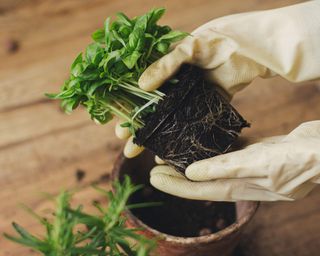
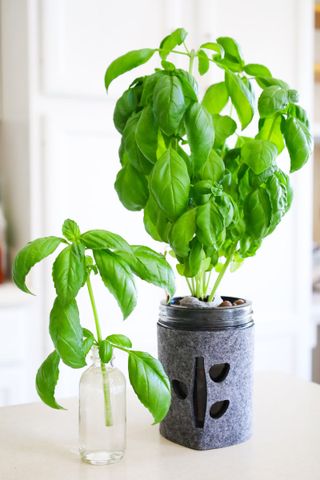
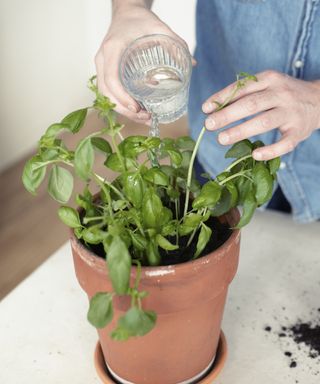
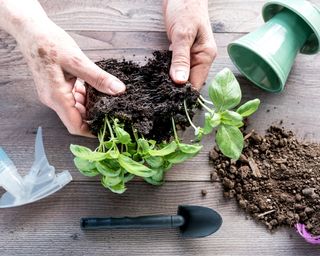
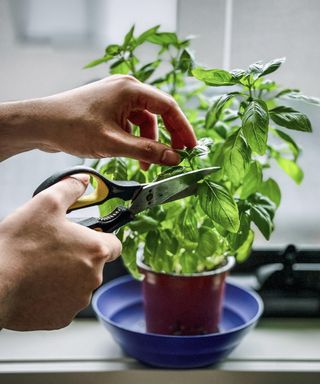
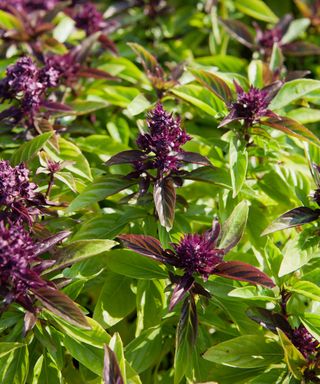
title: “How To Grow Basil Indoors For Fresh Year Round Flavor” ShowToc: true date: “2024-10-21” author: “Ruth Adams”
Growing basil in the garden is a popular activity in the spring and summer months. But, the plants are not cold hardy so quickly die off in the fall. You can get the best of both worlds by growing basil in containers outdoors, then bringing them inside during fall and winter. However, growing basil indoors is possible whether you have a garden or not.
How To Grow Basil Indoors
It’s not difficult to learn how to grow basil indoors. It can be grown on the kitchen windowsill for use in cooking, for making aromatic oils, or simply to add interest to an indoor herb garden. Our expert guide will take you through the key steps, from planting to care, and harvesting.
How To Care For Basil Indoors
Basil plant care indoors is all about providing it with the right conditions: This hydroponic kit from Coco & Seed gives you everything you need to start growing your own indoor basil right away. Only $25!
Light
When growing basil indoors, lighting is important. The herb requires at least six hours of sunlight each day, so should be placed in a sunny window, preferably facing south. Otherwise, indoor basil plants may need to be grown under fluorescent lights. With this type of lighting, basil plants will need about 10 hours of light for healthy growth. However, basil grown indoors can also be given both sun and artificial lighting by alternating so many hours in each.
Water
Watering basil effectively is key to its success – the plants require constantly moist, but never soggy soil. How often to water basil indoors depends on how quickly the soil begins to dry out. Check frequently by pushing your finger down into the soil; when the top inch is dry, it’s time to water.
Temperature & Humidity
Basil will tolerate a range of indoor temperatures as long as it doesn’t get too cold. Temperatures between 50 and 80 degrees Fahrenheit (10 and 27 Celsius) are ideal. Basil doesn’t need a lot of humidity as long as you keep the soil consistently moist. If the air is very dry in your house, give the plant an occasional spritz of water.
Soil
Grow basil in well-drained, nutrient-rich soil. A high-quality potting soil or soilless mix are good options. The soil and the container should drain well. Basil likes moist soil but will rot if it gets too soggy. Healthy pH levels are an important aspect of quality soil. When learning how to grow basil indoors, it’s worth occasionally checking the pH levels of soil. Sufficient pH levels are usually between 6.0 and 7.5.
Fertilizing
Fertilizing basil plants is a careful balance. The herb requires nutrients, but should never be over-fertilized, as it can result in spindly growth and less flavorful leaves. Apply a diluted solution of 5-10-5 fertilizer a couple of times during the growing season. Use it at half the recommended strength. Basil used solely for flavoring foods requires the use of an organic fertilizer, which also helps to maintain pH levels when growing basil indoors.
How to Plant Basil Indoors
There are several options for planting basil indoors. You can dig up basil growing in an outdoor bed and put it in a container for indoors. Choose a container that drains well and use a quality potting mix. Alternatively, planting basil seeds directly in a container is an inexpensive way of having a constant fresh supply. Simply plant new seeds every few weeks. Repotting grocery store basil is also a great way to quickly fill your windowsill herb garden with five or six plants at a low cost. In addition, propagating basil is very easy by rooting stem cuttings in water or soil. While growing basil indoors is an easy endeavor, the vigorous growth of plants means they may require frequent repotting.
Pruning Indoor Basil Plants
Pinch off leaves and short stem segments regularly to encourage full growth. This will give you a bushier plant that produces more leaves. Pinch stems just above a leaf node. You should also pinch off basil flowers as they develop. This will ensure all of the plant’s energy goes towards foliage production, and maintains higher levels of essential oils in the leaves.
Harvesting Basil Indoors
Harvesting basil is possible as soon as the plant has at least six sets of leaves. Simply cut leaves as needed using clean, sharp scissors. You can either use the leaves fresh, or dry basil, which increases its intensity. You should harvest from the top down, and if cutting back entire stems, cut back to a third of the plant’s height, just above a leaf pair. To trim a basil plant without killing it, don’t remove more than half a plant at one time.
Best Basil Varieties To Grow Indoors
There are many varieties of basil that can be grown successfully indoors:
Sweet basil is the most common and standard variety of basil that has an excellent flavor. Try ‘Napoletano’ or ‘Romanesco’ varieties.Try ‘Pesto Perpetuo’ for a flavorful basil that bolts less readily than other varieties.Purple basils are pretty as well as tasty. Varieties include ‘Dark Opal’, ‘Red Rubin’, and ‘Purple Ruffles’.Many varieties of basil have unique flavors, including cinnamon basil, lemon basil, and lime basil.Regional varieties like Thai basil or Greek basil also offer variations on the classic sweet basil taste.
Problems, Pests & Diseases
Common basil diseases include mold and downy mildew, but this is often less of an issue indoors where the air is drier. Avoid crowding plants in containers to ensure good air flow between stems and leaves. Also avoid overwatering and ensure good drainage. Pests are also more of an outdoor issue. Basil can be attacked by aphids, spider mites, whiteflies, and Japanese beetles. If bringing a plant in from outside, check it carefully for pests and remove any you find. Droopy basil is a sure sign something is wrong, so keep an eye on your plants and check them for issues regularly. Love Gardening Know How? Our latest book, The Complete Guide to Vegetable Gardening, is available now! Knowing how to grow basil indoors is a simple matter of understanding this herb’s needs. You can keep a plant going by taking and rooting cuttings as often as you like. Perfect for the gardener in your life, or for your own coffee table, this book boasts 224 pages of high-quality pictures, expert tips, and easy-to-follow advice to get your vegetable garden growing its best. Look for it at these sellers, and wherever quality books are sold.






title: “How To Grow Basil Indoors For Fresh Year Round Flavor” ShowToc: true date: “2024-09-19” author: “Angelena Cain”
Growing basil in the garden is a popular activity in the spring and summer months. But, the plants are not cold hardy so quickly die off in the fall. You can get the best of both worlds by growing basil in containers outdoors, then bringing them inside during fall and winter. However, growing basil indoors is possible whether you have a garden or not.
How To Grow Basil Indoors
It’s not difficult to learn how to grow basil indoors. It can be grown on the kitchen windowsill for use in cooking, for making aromatic oils, or simply to add interest to an indoor herb garden. Our expert guide will take you through the key steps, from planting to care, and harvesting.
How To Care For Basil Indoors
Basil plant care indoors is all about providing it with the right conditions: This hydroponic kit from Coco & Seed gives you everything you need to start growing your own indoor basil right away. Only $25!
Light
When growing basil indoors, lighting is important. The herb requires at least six hours of sunlight each day, so should be placed in a sunny window, preferably facing south. Otherwise, indoor basil plants may need to be grown under fluorescent lights. With this type of lighting, basil plants will need about 10 hours of light for healthy growth. However, basil grown indoors can also be given both sun and artificial lighting by alternating so many hours in each.
Water
Watering basil effectively is key to its success – the plants require constantly moist, but never soggy soil. How often to water basil indoors depends on how quickly the soil begins to dry out. Check frequently by pushing your finger down into the soil; when the top inch is dry, it’s time to water.
Temperature & Humidity
Basil will tolerate a range of indoor temperatures as long as it doesn’t get too cold. Temperatures between 50 and 80 degrees Fahrenheit (10 and 27 Celsius) are ideal. Basil doesn’t need a lot of humidity as long as you keep the soil consistently moist. If the air is very dry in your house, give the plant an occasional spritz of water.
Soil
Grow basil in well-drained, nutrient-rich soil. A high-quality potting soil or soilless mix are good options. The soil and the container should drain well. Basil likes moist soil but will rot if it gets too soggy. Healthy pH levels are an important aspect of quality soil. When learning how to grow basil indoors, it’s worth occasionally checking the pH levels of soil. Sufficient pH levels are usually between 6.0 and 7.5.
Fertilizing
Fertilizing basil plants is a careful balance. The herb requires nutrients, but should never be over-fertilized, as it can result in spindly growth and less flavorful leaves. Apply a diluted solution of 5-10-5 fertilizer a couple of times during the growing season. Use it at half the recommended strength. Basil used solely for flavoring foods requires the use of an organic fertilizer, which also helps to maintain pH levels when growing basil indoors.
How to Plant Basil Indoors
There are several options for planting basil indoors. You can dig up basil growing in an outdoor bed and put it in a container for indoors. Choose a container that drains well and use a quality potting mix. Alternatively, planting basil seeds directly in a container is an inexpensive way of having a constant fresh supply. Simply plant new seeds every few weeks. Repotting grocery store basil is also a great way to quickly fill your windowsill herb garden with five or six plants at a low cost. In addition, propagating basil is very easy by rooting stem cuttings in water or soil. While growing basil indoors is an easy endeavor, the vigorous growth of plants means they may require frequent repotting.
Pruning Indoor Basil Plants
Pinch off leaves and short stem segments regularly to encourage full growth. This will give you a bushier plant that produces more leaves. Pinch stems just above a leaf node. You should also pinch off basil flowers as they develop. This will ensure all of the plant’s energy goes towards foliage production, and maintains higher levels of essential oils in the leaves.
Harvesting Basil Indoors
Harvesting basil is possible as soon as the plant has at least six sets of leaves. Simply cut leaves as needed using clean, sharp scissors. You can either use the leaves fresh, or dry basil, which increases its intensity. You should harvest from the top down, and if cutting back entire stems, cut back to a third of the plant’s height, just above a leaf pair. To trim a basil plant without killing it, don’t remove more than half a plant at one time.
Best Basil Varieties To Grow Indoors
There are many varieties of basil that can be grown successfully indoors:
Sweet basil is the most common and standard variety of basil that has an excellent flavor. Try ‘Napoletano’ or ‘Romanesco’ varieties.Try ‘Pesto Perpetuo’ for a flavorful basil that bolts less readily than other varieties.Purple basils are pretty as well as tasty. Varieties include ‘Dark Opal’, ‘Red Rubin’, and ‘Purple Ruffles’.Many varieties of basil have unique flavors, including cinnamon basil, lemon basil, and lime basil.Regional varieties like Thai basil or Greek basil also offer variations on the classic sweet basil taste.
Problems, Pests & Diseases
Common basil diseases include mold and downy mildew, but this is often less of an issue indoors where the air is drier. Avoid crowding plants in containers to ensure good air flow between stems and leaves. Also avoid overwatering and ensure good drainage. Pests are also more of an outdoor issue. Basil can be attacked by aphids, spider mites, whiteflies, and Japanese beetles. If bringing a plant in from outside, check it carefully for pests and remove any you find. Droopy basil is a sure sign something is wrong, so keep an eye on your plants and check them for issues regularly. Love Gardening Know How? Our latest book, The Complete Guide to Vegetable Gardening, is available now! Knowing how to grow basil indoors is a simple matter of understanding this herb’s needs. You can keep a plant going by taking and rooting cuttings as often as you like. Perfect for the gardener in your life, or for your own coffee table, this book boasts 224 pages of high-quality pictures, expert tips, and easy-to-follow advice to get your vegetable garden growing its best. Look for it at these sellers, and wherever quality books are sold.





